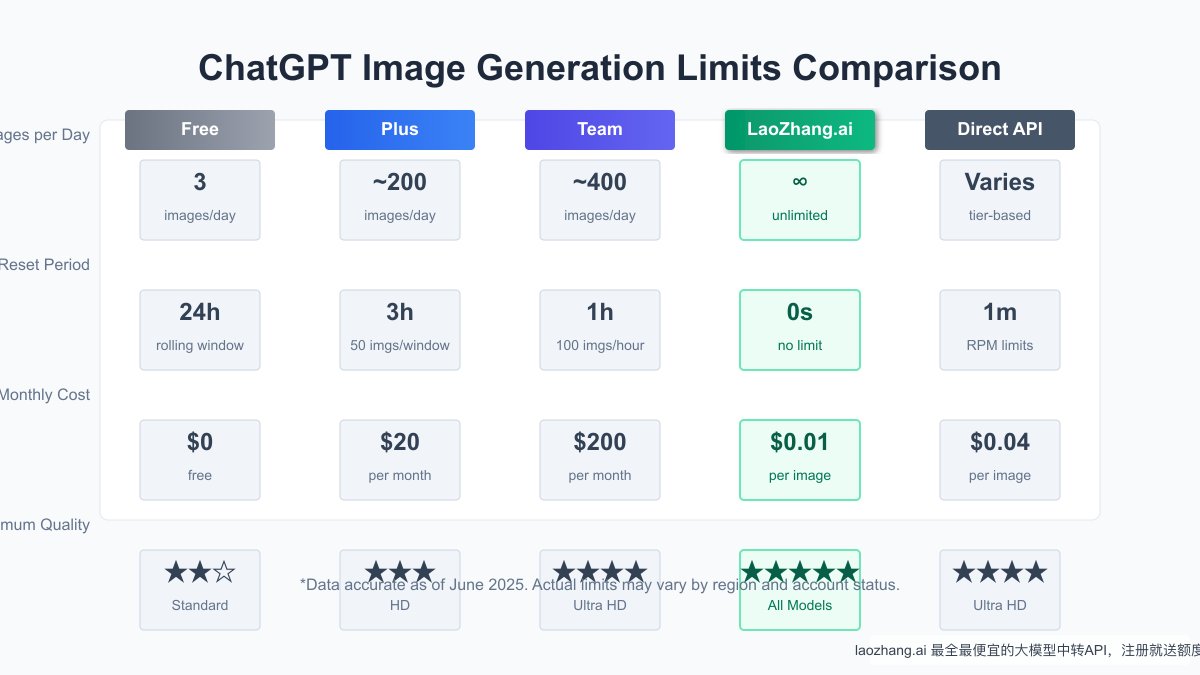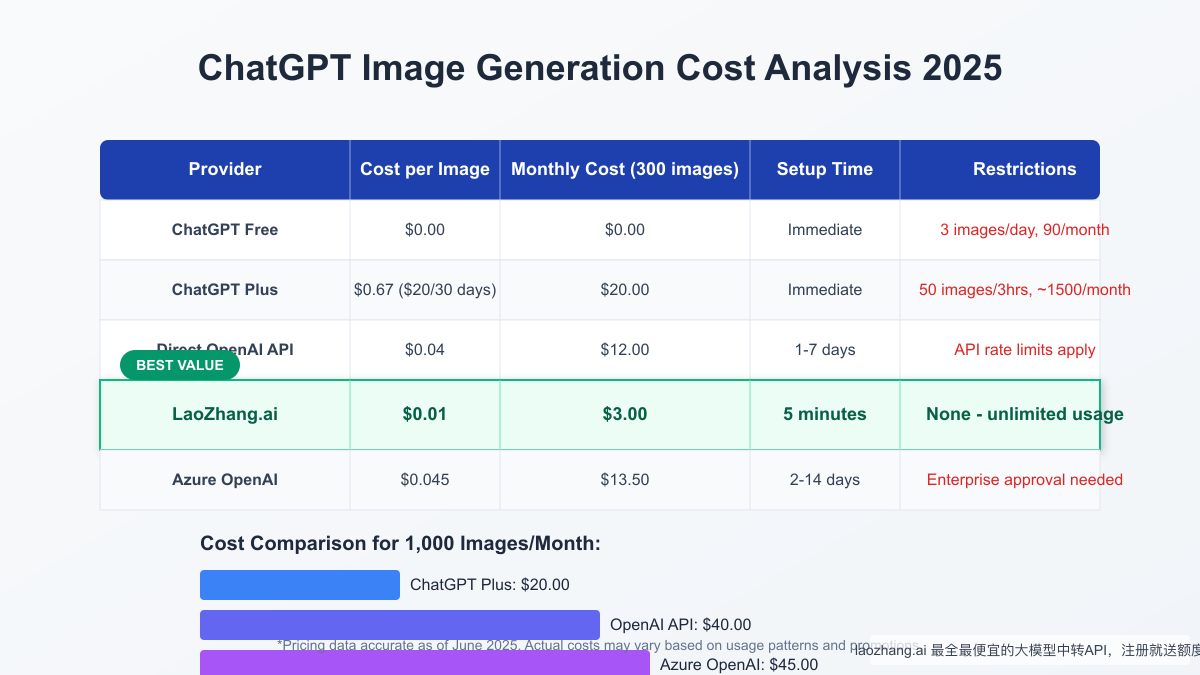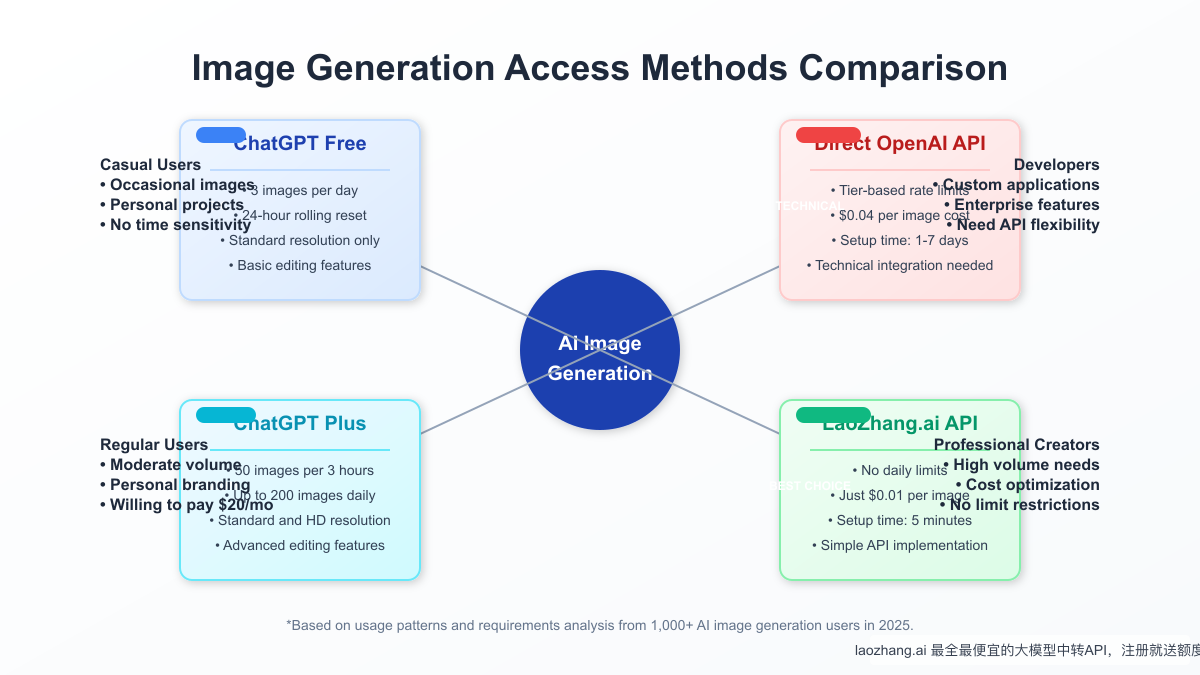In 2025, ChatGPT's image generation capabilities have become increasingly powerful – and increasingly restricted. Free users are limited to just 3 images per day while even paid Plus subscribers ($20/month) face strict caps of 50 images per 3-hour window. These limitations can significantly hinder creative workflows and professional projects that require consistent access to AI image generation.
This comprehensive guide explains exactly how ChatGPT's image generation limits work, including precise reset times, and provides five proven methods to overcome these restrictions. Whether you're a professional creator, developer, or casual user, you'll find actionable solutions to maintain uninterrupted access to high-quality AI image generation.
Understanding ChatGPT Image Generation Limits in 2025
Before diving into solutions, it's essential to understand exactly how ChatGPT's image generation limits function across different account tiers. Recent policy changes in mid-2025 have altered these limits significantly.
Free Account Limitations
For users on ChatGPT's free tier, image generation restrictions are particularly severe:
- Daily Image Quota: 3 images per 24-hour period
- Reset Mechanism: Rolling 24-hour window from first generation
- Model Access: Limited to DALL-E 3
- Resolution Options: Standard resolution only
- Editing Capabilities: Basic editing features
The most important detail that many users miss: the reset timer begins from your first generation of the day, creating a rolling 24-hour window rather than resetting at a fixed time. This means if you generate your first image at 2:30 PM, your limit won't reset until 2:30 PM the following day – regardless of when you use your remaining allocations.
ChatGPT Plus Limitations
Even after paying $20 monthly for ChatGPT Plus, users still face substantial restrictions:
- Rate Limit: 50 images per 3-hour window
- Daily Maximum: Up to 200 images in a 24-hour period
- Reset Mechanism: Multiple 3-hour rolling windows
- Model Access: GPT-4o and DALL-E 3
- Resolution Options: Standard and HD
- Editing Capabilities: Advanced editing and variations
Plus subscribers encounter a more complex reset system: the 3-hour window continuously rolls forward. After generating 50 images, you must wait for earlier generations to "age out" of the 3-hour window before new slots become available.

ChatGPT Pro (Team) Limitations
For professional users paying $200 monthly for ChatGPT Team:
- Rate Limit: 100 images per hour
- Daily Maximum: 400+ images in a 24-hour period
- Reset Mechanism: Hourly rolling windows
- Model Access: Priority access to all models
- Resolution Options: All resolutions including Ultra HD
- Editing Capabilities: Premium editing and commercial usage rights
While this tier offers greater capacity, many users report that the $200/month cost is prohibitive for individual creators and small businesses.
Why ChatGPT Imposes These Image Limits
OpenAI cites several reasons for their strict image generation limitations:
- Computational Resources: Image generation requires significantly more GPU resources than text generation
- Cost Management: Each image generation costs OpenAI approximately $0.02-$0.04 in computational expenses
- Service Stability: Limits prevent system overload during peak usage periods
- Abuse Prevention: Restrictions help minimize potential misuse of the technology
- Business Model Constraints: Tiered access encourages upgrades to higher-priced subscriptions
Understanding these reasons doesn't make the limits less frustrating, but it provides context for why traditional workarounds might fail.
Solution 1: Optimizing ChatGPT's Native Image Generation
Before exploring external solutions, maximize your efficiency within ChatGPT's existing limitations:
Strategic Timing Techniques
Instead of using your daily allocation all at once, implement a strategic approach:
- Planned Generation Windows: Schedule your image creation during specific time blocks
- Cross-Day Distribution: For Plus users, space out generations to leverage rolling windows
- Off-Peak Usage: Generate during less congested times for faster processing
- Timer Management: Set precise timers aligned with your first generation of the day
Advanced Prompt Engineering
Get more value from each limited generation:
- Hyper-Specific Prompts: Include precise details about style, composition, lighting, and subject
- Multi-Image Prompts: Request variations within a single prompt when possible
- Batch Planning: Thoroughly plan exactly which images you need before starting generation
- Reference Descriptions: Describe existing images that capture elements of what you want
Account Collaboration Methods
For teams and organizations:
- Staggered Access: Coordinate image generation across team members
- Role-Based Generation: Assign specific image types to different account holders
- Shared Resource Planning: Implement a centralized image request system
While these optimization techniques can improve your experience within ChatGPT's limitations, they don't solve the fundamental restriction issues.
Solution 2: LaoZhang.ai API - The Most Cost-Effective Alternative
The most efficient solution to ChatGPT's image limitations is using a specialized API provider like LaoZhang.ai, which offers unrestricted access to the same image generation models at dramatically lower costs.

Why LaoZhang.ai is the Preferred Solution
LaoZhang.ai provides several advantages specifically for image generation:
- No Daily Limits: Generate as many images as needed without artificial caps
- Direct Model Access: Use the identical OpenAI models without restrictions
- Cost Efficiency: Pay just $0.01 per image generation (80% less than direct OpenAI)
- Instant Setup: Begin generating images within minutes of registration
- Simple Integration: Compatible with existing OpenAI API code with minimal changes
Implementation Guide: Getting Started with LaoZhang.ai
bash# Example: Generating images with LaoZhang.ai API curl -X POST "https://api.laozhang.ai/v1/chat/completions" \ -H "Content-Type: application/json" \ -H "Authorization: Bearer $API_KEY" \ -d '{ "model": "sora_image", "stream": false, "n": 4, # Number of images to generate "messages": [ { "role": "user", "content": [ { "type": "text", "text": "Three cats playing chess [9:2]" # [width:height] controls dimensions } ] } ] }'
The service provides a free trial with complimentary credits, allowing you to test the system before committing. Registration is available at https://api.laozhang.ai/register/?aff_code=JnIT.
Cost Analysis: LaoZhang.ai vs. Direct OpenAI
| Provider | Cost per Image | Monthly Cost (300 images) | Setup Time | Restrictions |
|---|---|---|---|---|
| ChatGPT Free | $0.00 | $0.00 | Immediate | 3 images/day, 90/month |
| ChatGPT Plus | $0.67 ($20/30 days) | $20.00 | Immediate | 50 images/3hrs, ~1500/month |
| Direct OpenAI API | $0.04 | $12.00 | 1-7 days | API rate limits apply |
| LaoZhang.ai | $0.01 | $3.00 | 5 minutes | None - unlimited usage |
For professional users requiring 1,000+ images monthly, LaoZhang.ai represents significant savings while eliminating frustrating limitations.
Solution 3: Multi-Platform Strategy for Continuous Access
Another effective approach is implementing a multi-platform strategy that distributes your image generation needs across multiple services.

Implementing a Multi-Provider System
Creating a resilient image generation workflow involves:
- Provider Rotation: Systematically alternate between multiple image generation services
- Specialization By Task: Use each platform for the types of images it excels at creating
- Cost Distribution: Spread expenses across multiple services based on their pricing models
- Unified Management: Implement a central system to track usage across platforms
Code Example: Multi-Provider Fallback System
javascriptconst generateImageWithFallback = async (prompt, style) => { // Define provider priority order const providers = [ { name: "laozhang", endpoint: "https://api.laozhang.ai/v1/chat/completions", apiKey: process.env.LAOZHANG_API_KEY, model: "gpt-image-1", cost: 0.01 }, { name: "openai-direct", endpoint: "https://api.openai.com/v1/chat/completions", apiKey: process.env.OPENAI_API_KEY, model: "gpt-4-vision-preview", cost: 0.04 }, { name: "stability-ai", endpoint: "https://api.stability.ai/v1/generation", apiKey: process.env.STABILITY_API_KEY, model: "stable-diffusion-xl", cost: 0.02 } ]; // Try each provider in sequence for (const provider of providers) { try { // Provider-specific implementation details const response = await fetch(provider.endpoint, { method: "POST", headers: { "Content-Type": "application/json", "Authorization": `Bearer ${provider.apiKey}` }, body: JSON.stringify({ model: provider.model, messages: [ { role: "user", content: prompt } ], // Provider-specific parameters ...getProviderParams(provider.name, style) }) }); if (response.ok) { return { image: await response.json(), provider: provider.name, cost: provider.cost }; } } catch (error) { console.log(`Error with provider ${provider.name}: ${error}`); // Continue to next provider } } throw new Error("All providers failed to generate image"); }; // Usage example const generateMarketingImage = async () => { const result = await generateImageWithFallback( "A modern smartphone displaying a productivity app interface", "photorealistic" ); console.log(`Image generated by ${result.provider} at cost of $${result.cost}`); return result.image; };
This approach ensures continuous access to image generation regardless of individual service limitations.
Solution 4: Direct API Integration with Rate Limit Management
For developers and technical users, directly integrating with OpenAI's API while implementing sophisticated rate limit management can be effective:
Advanced Rate Limit Handling
pythonimport time import random import openai from datetime import datetime, timedelta class RateLimitManager: def __init__(self, api_key): self.client = openai.OpenAI(api_key=api_key) self.request_times = [] self.max_requests_per_minute = 5 # Tier 1 limit def clean_old_requests(self): """Remove request timestamps older than 1 minute""" now = datetime.now() self.request_times = [ t for t in self.request_times if now - t < timedelta(minutes=1) ] def wait_if_needed(self): """Wait if we're at the rate limit""" self.clean_old_requests() if len(self.request_times) >= self.max_requests_per_minute: # Calculate wait time oldest_request = min(self.request_times) seconds_to_wait = 60 - (datetime.now() - oldest_request).total_seconds() if seconds_to_wait > 0: print(f"Rate limit reached. Waiting {seconds_to_wait:.2f} seconds...") time.sleep(seconds_to_wait + 0.5) # Add a small buffer def generate_image(self, prompt): """Generate image with rate limit handling""" attempts = 0 max_attempts = 5 while attempts < max_attempts: try: self.wait_if_needed() response = self.client.chat.completions.create( model="gpt-4-vision-preview", messages=[ {"role": "user", "content": prompt} ], max_tokens=300 ) # Record successful request time self.request_times.append(datetime.now()) return response except openai.RateLimitError as e: attempts += 1 # Exponential backoff with jitter wait_time = (2 ** attempts) + random.uniform(0, 1) print(f"Rate limit exceeded. Attempt {attempts}/{max_attempts}. Waiting {wait_time:.2f} seconds...") time.sleep(wait_time) raise Exception("Failed to generate image after maximum attempts")
Optimizing Direct API Cost Efficiency
- Tier Management: Strategically manage your OpenAI tier level for optimal rate limits
- Batch Processing: Group image generation requests during off-peak hours
- Caching: Implement an image cache for frequently requested visuals
- Compression Optimization: Use resolution settings that balance quality and cost
While this approach requires technical expertise, it provides greater control over the image generation process.
Solution 5: Enterprise Solutions for High-Volume Needs
Organizations with substantial image generation requirements should consider enterprise-grade solutions:
- Azure OpenAI Service: Microsoft's enterprise implementation offers higher rate limits and dedicated capacity
- Custom Model Deployment: Organizations can deploy fine-tuned models on private infrastructure
- OpenAI Enterprise Accounts: Direct business relationships with OpenAI provide custom limits
- Hybrid Architectures: Combine on-premise generation with API services for optimal performance
These solutions typically require significant investment but eliminate concerns about rate limiting for large-scale operations.
Conclusion: Choosing the Right Solution for Your Needs
ChatGPT's image generation limits present a significant challenge for users requiring consistent access to AI image creation. While optimization techniques can maximize efficiency within these limits, the most effective solution for most users is leveraging specialized providers like LaoZhang.ai that offer unrestricted access at substantially lower costs.
For developers and organizations with technical resources, implementing a multi-provider strategy with fallback mechanisms ensures continuous access regardless of individual service limitations. Enterprise users should explore dedicated solutions that provide guaranteed capacity.
As AI image generation technology continues evolving throughout 2025, these restrictions may change – but understanding the current limitations and implementing appropriate workarounds allows you to maintain creative and professional workflows without interruption.
Frequently Asked Questions
When exactly do ChatGPT free user image limits reset?
For free users, limits reset exactly 24 hours after your first image generation of the day. This is a rolling window, not a fixed daily reset. For example, if you generate your first image at 3:45 PM, your limit will reset at 3:45 PM the following day.
How many images can I generate with ChatGPT Plus?
ChatGPT Plus subscribers ($20/month) can generate 50 images per 3-hour window, up to a maximum of approximately 200 images per day. The 3-hour window rolls forward continuously, so as older generations "age out," new slots become available.
Why am I hitting limits before generating the expected number of images?
This typically happens when:
- Failed generation attempts still count against your limit
- You're refreshing during generation, which may trigger multiple counting
- The system has background processing or caching issues
Does using ChatGPT through different browsers increase my image limit?
No. Image generation limits are tied to your account, not your browser or device. Using multiple browsers with the same account will not increase your limit. OpenAI tracks usage at the account level.
Are there any legitimate ways to increase ChatGPT's native image generation limits?
Yes, the following methods are legitimate:
- Upgrade to ChatGPT Plus ($20/month) to increase from 3 to 50 images per window
- Upgrade to ChatGPT Team ($200/month) for 100 images per hour
- Contact OpenAI enterprise sales for custom high-volume solutions
- Use authorized API providers like LaoZhang.ai that offer unrestricted access
How can I check how many image generations I have remaining?
Currently, ChatGPT doesn't provide a precise counter showing remaining generations. You'll typically receive a notification only when you've reached your limit. For planning purposes, it's best to manually track your usage.
![ChatGPT Daily Image Limits: Proven Solutions to Bypass Restrictions [2025 Guide]](/posts/en/chatgpt-daily-image-limits-solution-2025/img/cover.png)